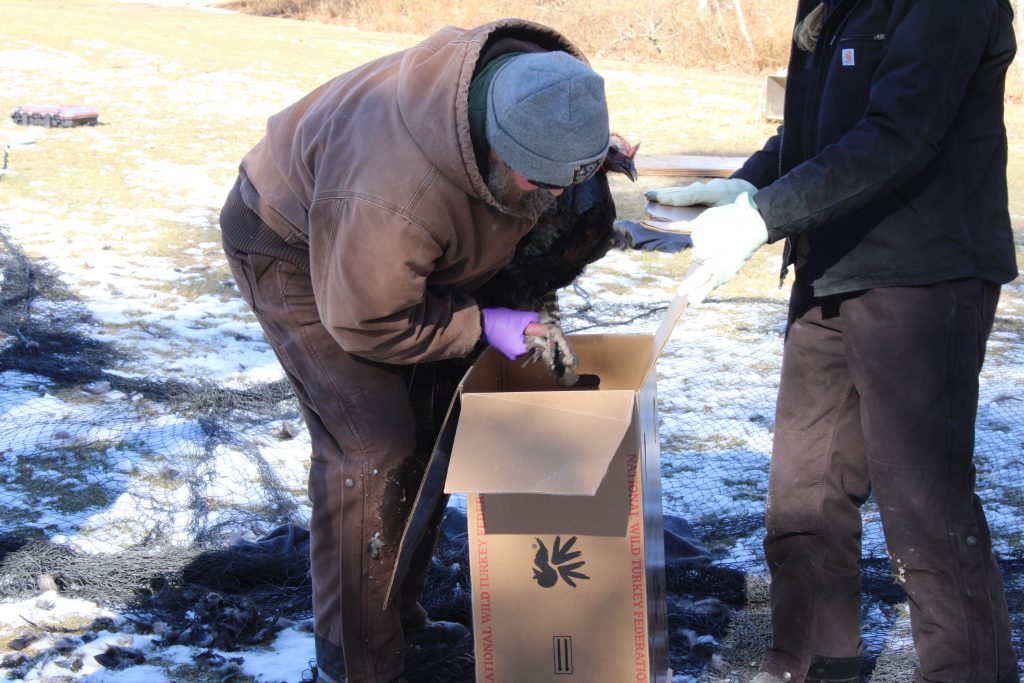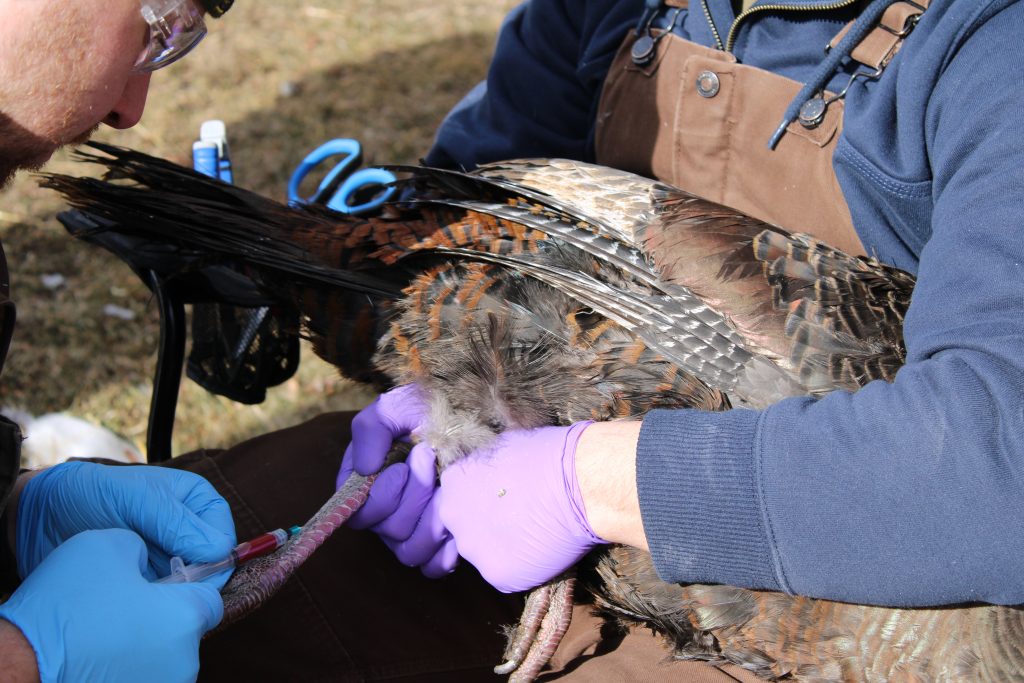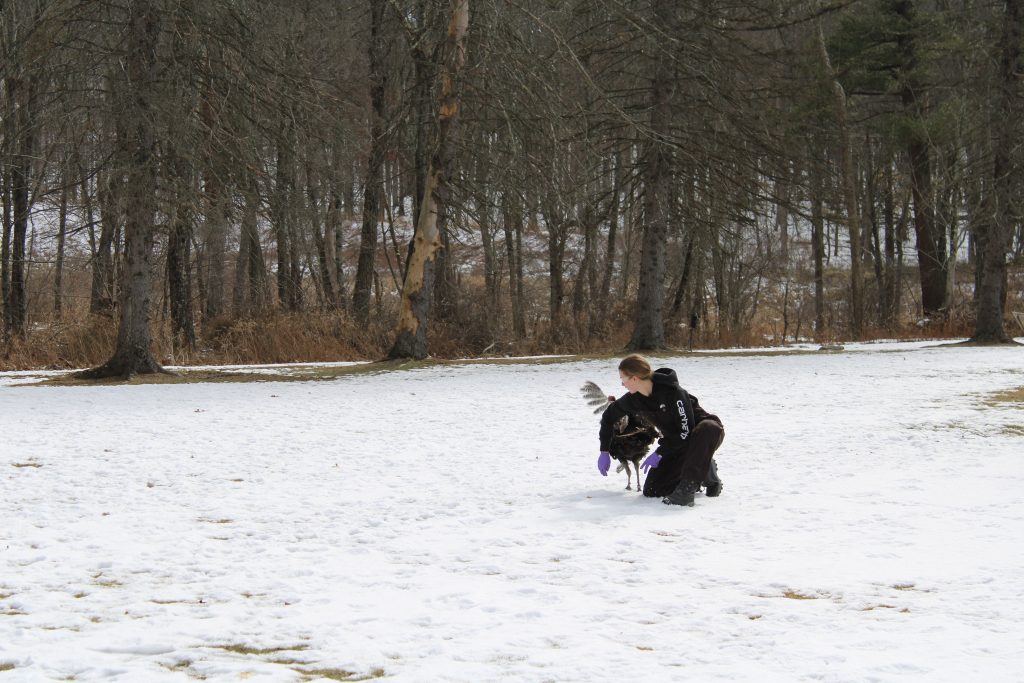Pennsylvania Game Commission Traps Wild Turkeys for Hen Survival Research
EDGEFIELD, S.C. – In northeastern Pennsylvania, biologists are in their fourth and final year of a hen population dynamics study, which is part of the larger Mid-Atlantic Wild Turkey Collaborative regional study. The NWTF is a proud partner of this work.
“To better understand this complex and dynamic nature of turkey populations, the Pennsylvania Game Commission, in cooperation with Penn State University and the University of Pennsylvania’s Wildlife Futures program, launched an ambitious four-year wild turkey field study in 2022,” said Mary Jo Casalena, PGC wild turkey biologist and NWTF National Wild Turkey Technical Committee representative. “Recognizing the benefits of a multi-state approach, Maryland and Ohio began research in 2023, followed by New Jersey and West Virginia in 2024. Ohio State University and West Virginia University are integral to the efforts in their respective states. State and local NWTF chapters are providing important financial support in some, if not all, states.”
Pennsylvania Game Commission research crew members from the study area in northeast Pennsylvania, Andrew Cushman, Alex Sessock, Karissa Hough and Rachel Olver, along with the northeast region wildlife management supervisor, Kevin Wenner, had another successful turkey trapping for their efforts in the research project last week, bringing them closer to their seasonal goal. The primary focus of this research project is to assess limiting factors of hen populations to better understand what impacts hen habitat use, movement, survival and nest success.
Each state in the study has anywhere from two to five study areas that represent different habitats and turkey population densities. Pennsylvania has four. The Wildlife Management Units are designated as 2D in western Pennsylvania, 3D in northeastern Pennsylvania, 4D in central Pennsylvania and 5C in southeastern Pennsylvania.
Before the break of dawn, joined by a team of additional PGC personnel and NWTF staff and volunteers, the research crew set up a rocket net in a landowner’s front yard. The site selection was a suggestion from Frank Antoniacci, NWTF volunteer and state board member, who always saw turkeys at this location when he was driving to work.
“I was seeing them there for a good month or so, and if I think somethings relevant, I’ll call Andrew or Alex,” Antoniacci said. “It doesn’t take much. I’m just lucky this project happened to be in my area.”
After a few hours of patience, gobblers and hens emerged from the tree line. The rocket net was detonated, wild turkeys were caught and swiftly put into boxes. Hens were set to the left, and gobblers were set to the right, as the procedure for hens and gobblers is different for this study.

One at a time, hens were removed from their box by a crew member who would hold the bird while another crew member attached a leg band, took blood samples, swabs and attached a small transmitter. These procedures are used to accomplish the project’s four main objectives. Gobblers were measured, banded and released.

The transmitters help the researchers at Penn State and the University of Pennsylvania assess how hen habitat-use and movement behaviors vary based on habitat types, weather patterns, predation rates and disease prevalence. Researchers also assess the factors that impact hen survival and how those impacts differ according to habitat types.
The study seeks to understand how factors like habitat, predation and disease affect turkey productivity and nest success. Taking blood samples, fecal samples and oral swabs from each hen helps researchers test for diseases and determine how they may be related to hen productivity, survival and movement across the landscape.
Penn State and UPenn's Wildlife Futures Program analyze data collected from Pennsylvania, Maryland and New Jersey, while Ohio State University and West Virginia University analyze their states data, which allows graduate and postdoc students to be involved. Once all data are collected, the universities and state agencies will further analyze the data for regional analyses.
Field crews collect the data, researchers at Penn State and UPenn conduct the analyses and then they will provide their reports to Casalana and the PGC to interpret and implement the recommendations.
“We created the Mid-Atlantic Wild Turkey Research Collaborative to obtain a large enough sample size to develop sound conclusions and management recommendations,” Casalana said. “We reached out to our neighboring states for a regional study.”
Funding is provided by each state agency and university, the U.S Fish and Wildlife Service Pittman-Robertson Fund, as well as through the NWTF. The NWTF state chapters also help with the purchasing of equipment and dedicated volunteerism, like Antoniacci’s help with site selection and trapping.
The day’s trapping was a success, with seven hens and eight gobblers captured, each released back into the wild after being measured and tagged.

About the National Wild Turkey Federation
Since 1973, the National Wild Turkey Federation has invested over half a billion dollars into wildlife conservation and has positively impacted over 24 million acres of critical wildlife habitat. The NWTF has also invested over $10 million into wild turkey research to guide the management of the wild turkey population and to ensure sustainable populations into perpetuity. The organization continues to deliver its mission by working across boundaries on a landscape scale through its Four Shared Values: clean and abundant water, healthy forests and wildlife habitat, resilient communities, and robust recreational opportunities. With the help of its dedicated members, partners and staff, the NWTF continues its work to provide Healthy Habitats. and Healthy Harvests. for future generations.
